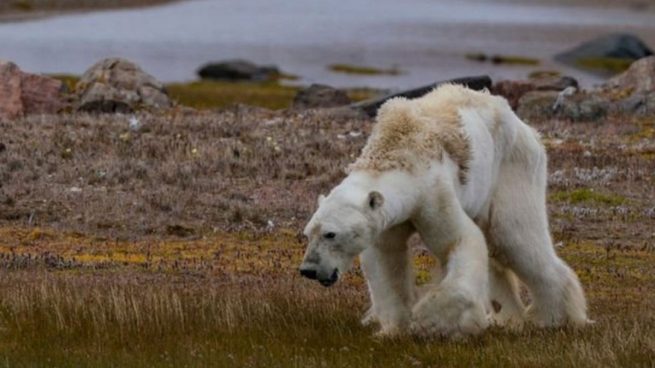El vídeo sobre el cambio climático que ha dado la vuelta al mundo
En él, se ve a un oso polar hambriento y moribundo en un paisaje del Ártico sin nieve
Este pez es una de las peores especies invasoras que vive en los ríos de España y casi nadie lo sabe
Las abuelas cocineras lo utilizan siempre: el truco sin salsa rosa ni mayonesa para que los langostinos queden deliciosos

Millones de personas en todo el planeta amanecieron el pasado 13 de diciembre con un nudo en el estómago. ¿El motivo? Un vídeo viral que muestra a un oso polar desnutrido, hambriento y moribundo mientras vaga sin fuerzas por las montañas de la Isla de Baffin, en Canadá. El autor de tan desgarradoras imágenes es Paul Nicklen, biólogo y fotógrafo de National Geographic, quien ha liderado una campaña para concienciar sobre las terribles consecuencias del calentamiento global.
«Todo mi equipo estaba luchando contra las lágrimas y sus emociones mientras grabábamos a este oso moribundo. Es una escena aplastante que todavía me atormenta. Pero sé que debemos compartir tanto lo bello como lo desgarrador si queremos derribar los muros de la apatía. Así es cómo se ve el hambre. Los músculos se atrofian, sin energía. Es una muerte lenta y dolorosa», relata Nicklen a través de su cuenta oficial de Instagram, donde ha compartido con sus seguidores la polémica publicación.
Son muchas las personas que han criticado al fotógrafo y a su compañera en la ONG conservacionista Sea Legacy, Cristina Mittermeier, por no socorrer al animal y dar prioridad a la grabación que ahora ha dado la vuelta al mundo. «Estábamos demasiado lejos de cualquier pueblo para pedir ayuda. Y acercarnos a un depredador hambriento sin un arma hubiera sido una locura», se defiende Mittermeier.
¿Es culpa del cambio climático?
Las imágenes que ahora han visto la luz se remontan al pasado mes de agosto. Un fecha que hace presagiar el peor de los destinos para tan hermoso animal, que busca desesperado en la basura cualquier tipo de sustento. Según cree el propio Nicklen, el oso polar podría haber muerto unos días después de la filmación. Una suposición que todavía no ha sido confirmada, pues el equipo de Sea Legacy jamás regresó al lugar de los hechos.
La falta de alimento en su hábitat natural, el aumento de las temperaturas o el derretimiento de los polos obliga a los osos polares del Ártico a sobrevivir mucho más tiempo sólo con la grasa que almacenan en su interior. «La delgada estructura del oso, los huesos protuberantes y los músculos atrofiados son claros indicadores de que llevaba un tiempo prolongado muriéndose de hambre», describe Nicklen, quien espera que sus imágenes sirvan para concienciar a la humanidad sobre la importancia de frenar los efectos del cambio climático. Por el momento, el vídeo ya cosecha más de 20 millones de reproducciones.
Temas:
- Cambio climático









